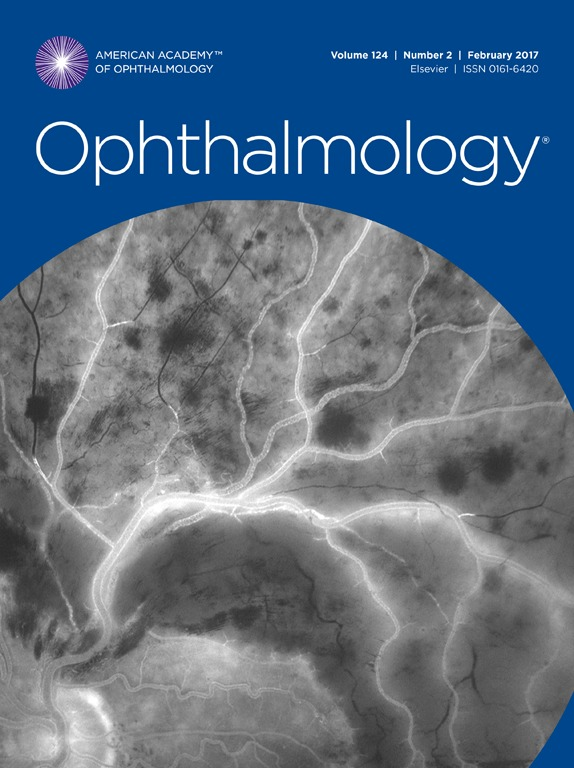Early Postoperative Conjunctival Complications Leading to Exposure of Surgically Implanted CorNeat EverPatch Devices
IF 13.1
1区 医学
Q1 OPHTHALMOLOGY
引用次数: 0
Abstract
Purpose
To compare the early exposure and surgical revision rates between a new synthetic tissue substitute (CorNeat EverPatch) with that of human donor cornea after placement onto the scleral surface during ophthalmic surgery and study the biomaterial properties of the synthetic patch material.
Design
Retrospective comparison study and biomaterial analyses of new and explanted synthetic patch material.
Participants
All consecutive patients who underwent ophthalmic surgery with implantation of the CorNeat EverPatch at the Wilmer Eye Institute (occurring from February through August 2024) and a comparison group who underwent ophthalmic surgery with implantation of irradiated donor cornea, matched 1:2 with patients receiving EverPatch for age, type of glaucoma, and surgeon.
Methods
Retrospective review of clinical electronic medical records of patients who underwent surgery at the Wilmer Eye Institute. Materials characterization of EverPatch, including morphologic features, surface roughness, wettability, thermal stability, elemental analysis, and physical properties.
Main Outcome Measures
Early exposure (within 5 months of surgery) and surgical revision rates after CorNeat EverPatch or irradiated human donor cornea implantation during ophthalmic surgery.
Results
Thirty patients undergoing ophthalmic surgery in 2024 received EverPatch implantation during primary tube shunt placement (n = 27), tube shunt revision (n = 2), or covering of exposed suture used for scleral fixation of an intraocular lens (n = 1). During the early postoperative period, the rate of EverPatch exposure was 48.3% and the rate of surgical revision was 27.9%. In case-matched control participants (n = 58), the rate of patch graft exposure was 1.7% (P < 0.0001) and the rate of surgical revision was 1.7% (P < 0.0001). EverPatch devices constituted a randomly aligned fibrous mesh with an average fiber diameter of 1.36 ± 0.78 μm, surface roughness of 1.3 ± 0.1 μm, pore size of 3.7 ± 0.4 μm2, and percent porosity of 37 ± 3%. Explanted EverPatch devices demonstrated varying degrees of tissue integration with significantly increased wettability and changes in thermal stability and elemental composition.
Conclusions
The rate of early conjunctival complications leading to exposure of the CorNeat EverPatch was higher than that of irradiated human donor corneal patch grafts.
Financial Disclosure(s)
Proprietary or commercial disclosure may be found in the Footnotes and Disclosures at the end of this article.
术后早期结膜并发症导致手术植入CorNeat EverPatch设备暴露。
目的:比较一种新型人工组织替代物(CorNeat EverPatch)与人供角膜在眼科手术中放置于巩膜表面后的早期暴露率和手术翻修率,研究人工组织替代物的生物材料特性。设计:回顾性比较研究;新的和外植的合成贴片材料的生物材料分析。患者:所有在Wilmer眼科研究所连续接受眼科手术植入CorNeat EverPatch的患者(发生于2024年2月至8月)和接受眼科手术植入辐照供体角膜的对照组,与接受EverPatch的患者在年龄、青光眼类型和外科医生方面匹配1:2。方法:回顾性分析在Wilmer眼科研究所接受手术的患者的临床电子病历。EverPatch的材料特性包括形态、表面粗糙度、润湿性、热稳定性、元素分析和物理性能。主要观察指标:眼科手术中CorNeat EverPatch或辐照的人供体角膜植入术后的早期暴露(手术5个月内)和手术翻修率。结果:2024年30例眼科手术患者在初级分流管置入术(N=27)、分流管翻修术(N=2)或覆盖暴露缝线用于巩膜固定人工晶状体(N=1)期间接受了EverPatch植入术。术后早期EverPatch暴露率为48.3%,手术翻修率为27.9%。在病例匹配的对照患者(N=58)中,补片暴露率为1.7% (p2),孔隙率为37±3%。外植的EverPatch设备表现出不同程度的组织整合,显著增加了润湿性,并改变了热稳定性和元素组成。结论:暴露于CorNeat EverPatch的早期结膜并发症发生率高于辐照的人供体角膜贴片移植。
本文章由计算机程序翻译,如有差异,请以英文原文为准。
求助全文
约1分钟内获得全文
求助全文
来源期刊

Ophthalmology
医学-眼科学
CiteScore
22.30
自引率
3.60%
发文量
412
审稿时长
18 days
期刊介绍:
The journal Ophthalmology, from the American Academy of Ophthalmology, contributes to society by publishing research in clinical and basic science related to vision.It upholds excellence through unbiased peer-review, fostering innovation, promoting discovery, and encouraging lifelong learning.
 求助内容:
求助内容: 应助结果提醒方式:
应助结果提醒方式:


